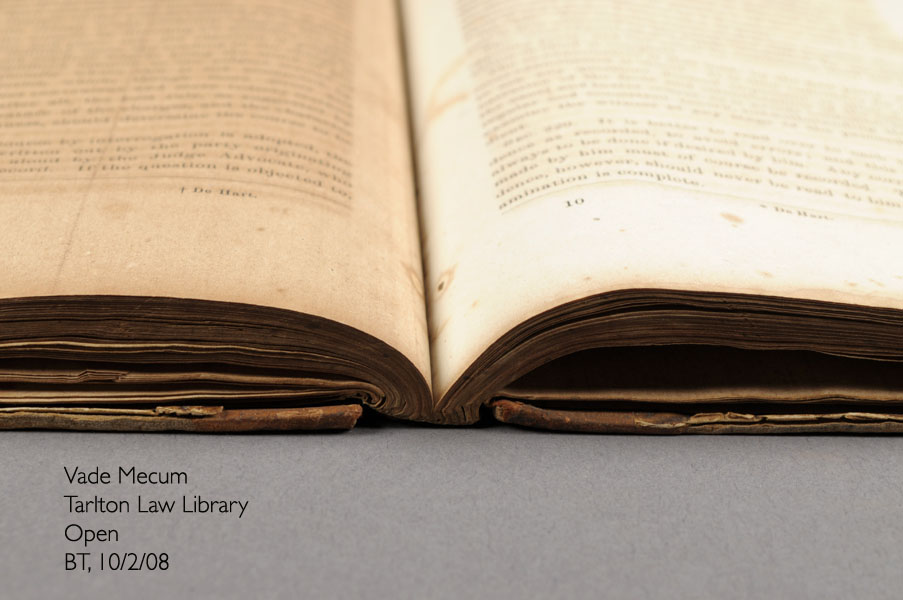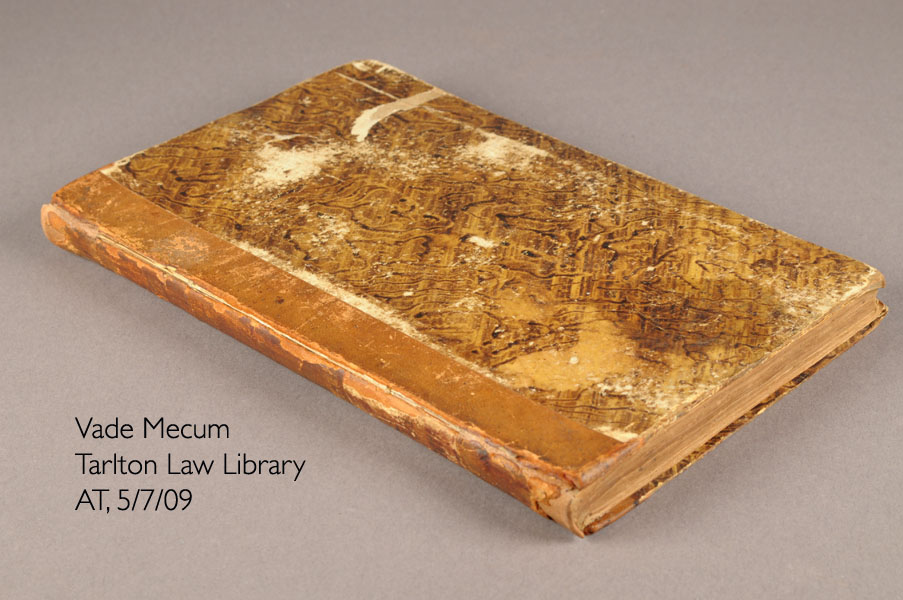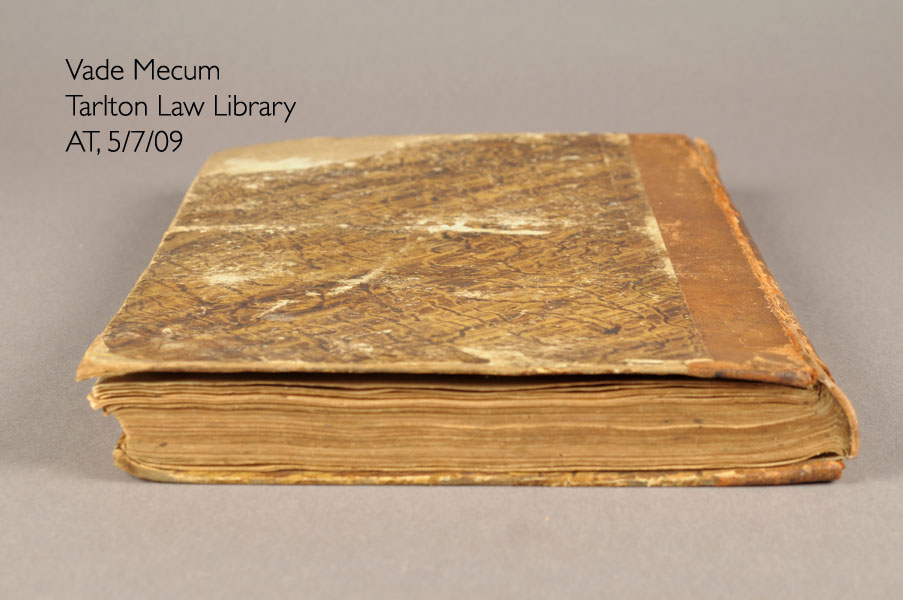Book Treatments
The Judge Advocate's Vade Mecum
Textblock consolidation, board reinforcement
Photo Documention
- Before
- During
- After
Click thumbnails to view images.
Treatment Report
PCS#: 08-107
ACCESSION OR CALL#: Tarlton Law library KFZ 9099 L44 1863
Author: Lee, Charles Henry (1818-1900)
Title: The Judge Advocate's Vade Mecum
Imprint: Published by West and Johnson: Richmond, 1863, Printed by Evans and Cogswell, Charleston, SC
Description:
The quarter style, rigid board, tight-back, tight-joint binding is covered in light brown leather and brown and cream paste paper. The leather is finished on the spine with four blind-tooled horizontal chain link lines dividing the spine into panels. There is a paper label adhered to the spine between the second and third bands. It is bordered with two lines and reads, “VADE MECUM” in red, brown, and black printing inks. The boards are attached to the textblock with two sawn-in sewing supports laced through the boards.
The moderately rounded and hammer backed textblock is sewn with a 2-on, two station sewing pattern on two single twisted cord supports with linen sewing thread. The smooth spine is covered with at least one paper lining, which is only visible at the areas of loss of covering material at the head and tail. It appears to be adhered with animal glue. The edges of the textblock are trimmed. The sewn on, single folio endleaves are similar to the text and are tipped to the first and last sections.
The textblock is comprised of quadruple folio sections of cream colored, smooth, medium weight wove, machine-made paper, and are printed with black printer’s ink. No watermarks were observed other than the mark of the paper making machine, noticeable on page 13. There is an unreadable name and date written in iron gall manuscript ink on the front pastedown. A cataloguer’s annotation is written in graphite on the first flyleaf, reading “printed during the confed” and “1500.”
Condition Summary:
The binding is in poor condition overall with tenuously attached boards and significant loss of covering material at the spine caps and both boards. The front board is detached three inches from the tail and one centimeter from the head, and the back board is attached only by the two sewing supports with both kettles broken and the leather torn the full length of the board. The leather and paper covering are severely abraded especially at the edges, and the paper is torn with large areas of loss on both boards. The front board, likely cross-grained, is badly warped, and the corners of both boards are soft and distorted.
The textblock is in poor condition overall with broken sewing and degraded paper. The sewing is broken at the front of the textblock, leaving two sections loose. The consolidation of the rest of textblock appears solid with no preferential openings. The edges of the loose sections are distressed and vulnerable to further damage, and the text paper exhibits a range of condition problems throughout. Some leaves exhibit an overall dark brown staining that has a brushed-on appearance, possibly caused by a degraded sizing agent. Other leaves have a darkened halo surrounding the text, likely oil staining from unstable printing ink. Many of these leaves also exhibit foxing and reverse foxing with the most severe example being the front endleaves. Much of the foxing floresces bright yellow under UV light. Most pages have tidelines at the tail.
Treatment Objective:
The goal of the treatment is to stabilize the object to allow safe handling by researchers in a special collections setting.
Treatment Proposal:
Treatment Option A:
- Re-house book in a phase box.
Treatment Option B:
- Lift spine covering at head and tail only, cutting at tooled lines.
- Clean and line exposed spine panels.
- Re-sew loose sections through spine lining.
- Reattach boards with overhanging textile lining under lifted leather.
- Reattach spine covering panels.
- Patch outer joints with toned long-fiber paper and touch-up with colored pencils.
- Reinforce corners.
- Re-adhere lifting marble paper covering and fill losses with toned long-fiber paper. Touch-up with colored pencils.
- Re-adhere lifting pastedown.
Treatment Option C:
- Disbind.
- Wash textblock and bleach/reduce staining of all leaves.
- Re-sew 2-on with recessed single supports using original sewing holes.
- Attach boards with overhanging textile lining adhered under lifted leather.
- Attach hollow tube and spine covering.
- Patch outer joint with toned long fiber paper and touch-up with colored pencil.
- Reinforce corners.
- Re-adhere lifting marble paper covering and fill losses with toned long-fiber paper. Touch-up with colored pencils.
- Re-adhere lifting pastedown.
Treatment Performed:
Treatment option B was selected by the Curator and will be performed.
- Mechanically lifted leather spine covering at head and tail in preparation for partial textblock lining and board attachment. (30 min)
- Cleaned exposed spine areas with Methyl cellulose [MC] and a microspatula. (30 min.)
- Adhered revisibility spine lining of 100% machine made kozo tissue with 60:40 wheat starch paste [WSP]/MC. (30 min)
- Lifted leather and pastedowns at spine edges. (45 min.)
- Toned aero-cotton overhanging lining material with de-ionized water diluted Liquitex acrylic paints and adhered them to the spine at the head and tail with Lascaux 498 HV. (30 min)
- Adhered overhanging portions of the textile lining to boards, partially under lifted pastedowns and partially under lifted leather. (2 hrs)
- Sewed loose sections (first two and last two) through textile lining with a two-twist of seaming twine. (1.5 hrs) See sewing pattern below:
- Toned Barrett Handmade Western paper and 100% Kozo tissue paper with de-ionized water diluted Liquitex acrylic paints for additional spine lining and spine covering infill. (3 hrs)
- Trimmed and sanded infill paper on all edges for a smooth transition on the spine, and formed caps by folding one edge over linen cord. Adhered infills to spine with Lascaux 498 HV, overhanging slightly following textile lining. (2 hrs)
- Re-adhered spine covering at head and tail with Lascaux 498 HV and let dry in lying press under Velcro boards. (30 min)
- Re-adhered lifted leather covering on boards, lifted pastedowns, and large area of detaching pastedown and paste paper on front board with Lascaux 498. (30 min)
- Reinforced adhesion of leather at edges of spine and boards with Lascaux. At the tail of the back board, adhered a small strip of toned 100% Kozo tissue to attach lifting leather at board edge to spine. (30 min)
- Reinforced board corners and adhered lifting paste paper covering with WSP. (3hrs)
- Mended torn pastedown and back flyleaf at hinge with toned lens tissue and WSP. (5 min)
- Touched up spine covering infill with colored pencils and artist pastels. (10 min)
- Created custom book shoe enclosure from blue museum board with PVA and a 4-ply mat board insert to support the textblock. (2 hrs)
Total Treatment Time: 18 hours
Materials used
- 100% machine-made Kozo tissue, Hiromi, 2004
- Green's Lens Tissue, Talas 2004
- UICB Barrett handmade Western paper, Talas, 2004
- Blue Museum Board
- 4-ply Mat board, White
- 100% linen seaming thread
- 100% Linen cord
- Airplane cotton, Test Fabrics, Inc.
- Methylcellulose, 4000 centipoises, 2.5% (w/v) diluted in hot then cold de-ionized water, Fisher Scientific
- Precipitated wheat starch paste, 4:1, cooked 20 minutes in de-ionized water, Colophon
- Lascaux 498 HV, Conservation Resources International
- PVAc
- Liquitex soft body acrylic paints, Burnt Sienna, Raw Sienna, Burnt Umber, Raw Umber
- Prismacolor colored pencils
- Soft pastels, Rembrandt
- Hollytex
- Blotter paper
- Mylar, Talas














































